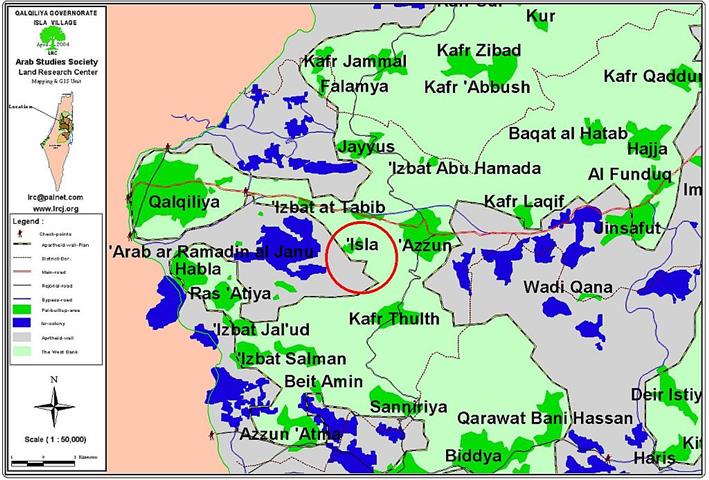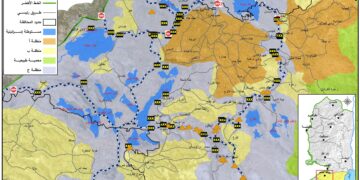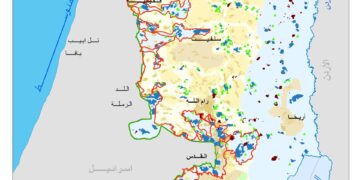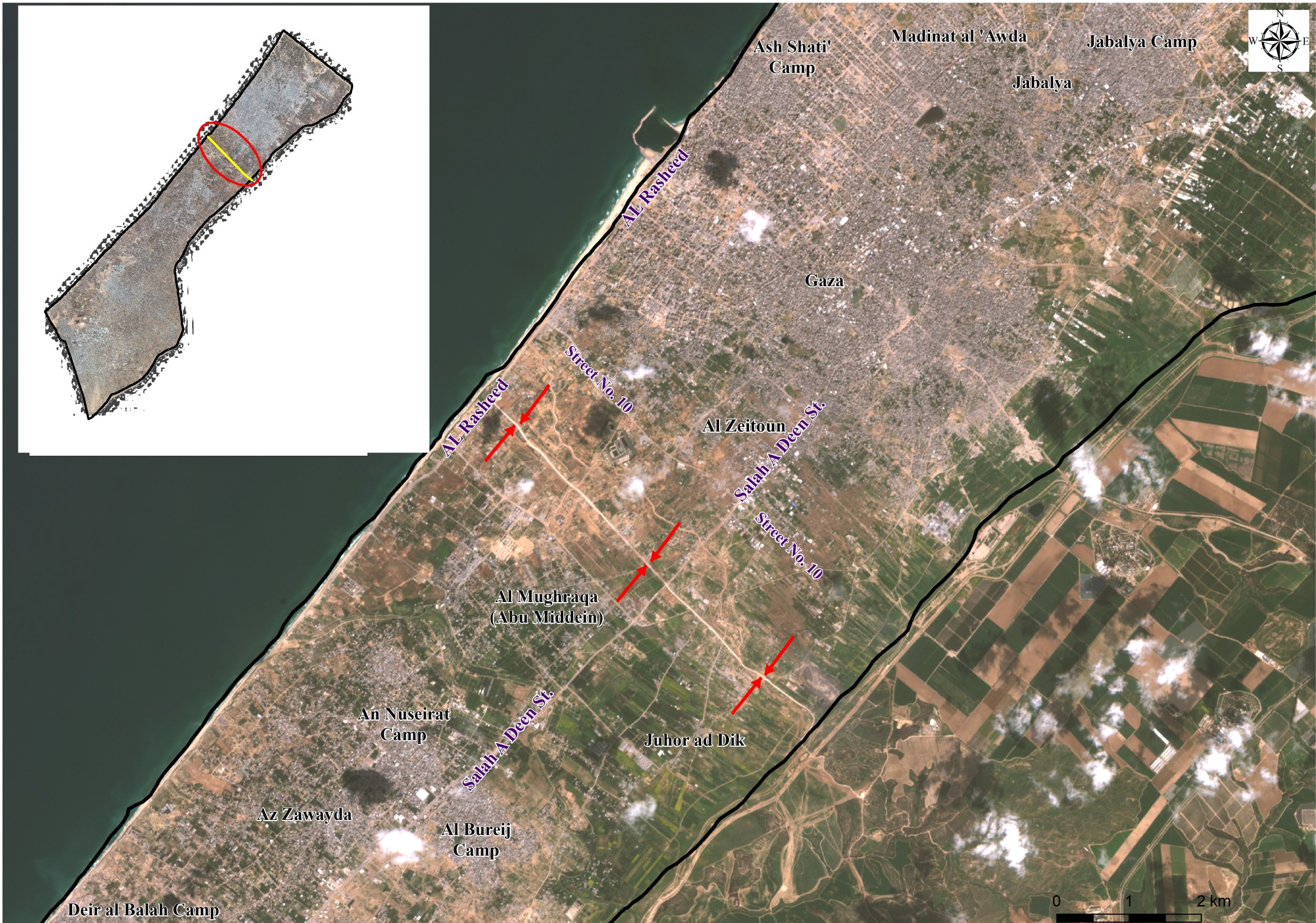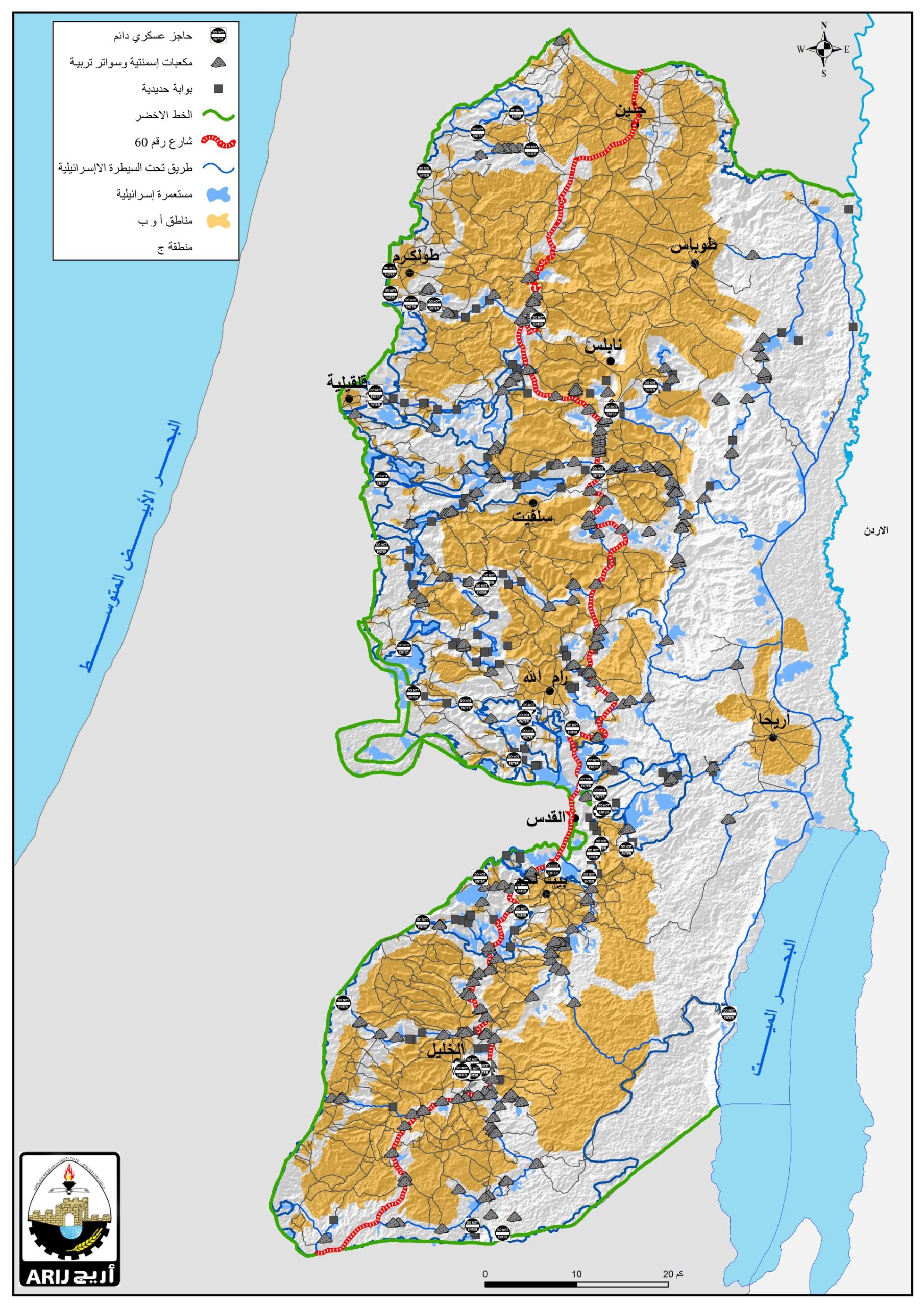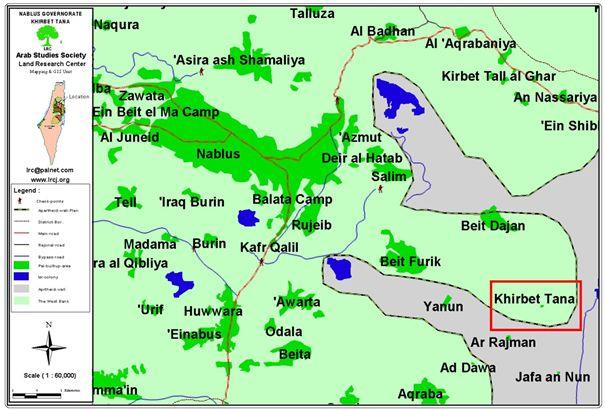'Eighty percent of the land of Isla village has been confiscated or separated by the Wall construction'
Location and Population
The village of Isla is located 9 kilometers south-of-east of the city of Qalqilia. Its pre-1967 population reached 650, yet the Six Day War witnessed the loss of about 30% of such population. The latest statistics (2002) indicated that its current population stood at 1,000.
The village is considered to be a natural extension of the nearby town of Azzun which used to reach as far as the Green Line. A large number of Azzun residents resorted to moving into Isla due to the fertility of its lands. See map of location
The village of Isla ( in red circle ) surrounded by the Separation Wall
The clan of Salman is considered the main family in the village as it constitutes 94% of the villages' residents. Other smaller clans also exist such as the Radi and Mas'oud families.
In terms of sources of income, during the pre-1967 days most of the population of the village depended largely on farming and cattle raising as the main source of income. Between the years 1967 and 2000 about 60% of Isla's population reverted to working inside of Israel, 32% worked in farming while 8% worked in governmental and private jobs. After the outbreak of the recent Uprising, working in farming the land has become, yet again, the main source of employment in the village until the Israeli Apartheid Separation Wall came in and transferred 73% of the population into unemployment.
Area of the Village
The current area of the village stands at about 10,000 dunums, 1,000 of which is used as built up area, while 8,850 dunums is currently filled with olive and citrus trees as well as cactuses. The remaining 150 dunums are used for growing wheat and barely.
In the year 1980 the village was subjected to an Israeli settlement campaign that led to the confiscation of 160 dunums in favor of the settlement of Alfei Menshe. In 1991 an additional 400 dunums were confiscated for the purpose of the enlargement of the said settlement. See Photo 1
The settlement of Alfei Menashe established on lands confiscated from Isla village and now surrounded by Separation Wall, Photo courtesy of LRC
Israeli Apartheid Separation Wall
The establishment of the Wall has led to the confiscation of about 80% of the lands of the village (about 8,000 dunums). It surrounds the village from its western direction as well as from its northwestern and southwestern directions. As a consequence, hundreds of residents of the village became jobless and the village became without lands needed for its natural future expansion.
The Effects of the Wall on the Village
A) Economic Effects:
The erection of the Wall has led to the plowing of about 150 dunums planted with olive and citrus trees as well as a large number of cactuses. To be more specific, the plowing process led to the uprooting of 560 olive trees, 150 citrus trees, in addition to 100 cactuses. Moreover, the Wall was designed to be erected very close to residents' houses as well as to cause the separation of 8,000 dunums behind it. As a result, Palestinians won't be able to access their fertile lands leading about 73% of Palestinians who depended on farming to become unemployed. Finally, the erection of the Wall has led to the confiscation of 15 water tanks located beyond it which were used for household consumption.
B) Social Effects:
The establishment of the Wall has led to a marked difficulty in the ability of the residents of the village to connect with their siblings in nearby villages. For example, in the pre-Wall era it used to take no more than 8 minutes to reach the village of Ras Tyra, 8 kilometers away from the village of Isla. Today, the process of reaching the said village requires going through a 24-kilometers strenuous mountainous roads. Moreover, Israeli occupation forces installed an iron gate in northwestern direction of the village. This gate (called No. 33) opens up three times a day only for about 20 minutes each time according to the following scheme:
-
7:15 AM to 7:35 AM
-
1:15 PM to 1:35 PM
-
5:15 PM to 5:35 PM
Isla- Qalqiliya- Wall gate number 33, Photo courtesy of LRC
However, the Israeli Army sometimes does not abide with this schedule as it has been documented that occasionally the gate is never opened. In addition, entry permissions are usually intentionally delayed and are sometimes not respected by the soldiers manning the gate.
C) Psychological Effects:
-
The Israeli Army fires, occasionally, live ammunition as well as light flares for the intentional purpose of terrifying Palestinian residents.
-
The humiliation policy adopted by the soldiers on the gate as well as delaying issuing the appropriate permits create a sense of despair and hopelessness among Palestinian farmers who are unable to reach their homes and/or their lands.
-
Most of the residents of the village get depressed when seeing the Wall surrounding them from all directions.
Tour of LRC's Field Worker in Isla
During his tour, LRC's field worker met a number of Palestinians who were harmed by the establishment of the Wall. They include:
-
Mr. Ghaleb Abdel Rahman Salman and his brothers: He is a farmer from the village of Isla who mentioned that the erection of the Wall has led to the loss of 100 dunums containing about 1,600 olive trees. Now, he owns no land, not even a small plot to be used for future building. Currently, he, along with the rest of family members, is not allowed to access his land due to ''security reasons.''
-
Mr. Anwar Omar Mas'oud: He is a farmer from Isla whose 50 dunums of his land were confiscated in 1990 for the benefit of the Israeli settlement of Alfe Menshe. In 2002 Israeli occupation forces impounded the rest of his land (about 150 dunums) to be used for Wall erection which left him land-less and lacking any viable chance to feed his family. He mentioned that he has hired a number of Israeli lawyers to defend his confiscated lands yet to no avail.
General Description of the Wall in Isla
The total length of the Wall established on the lands of Isla is 5.1 kilometers with a width of 80 to 90 meters. It surrounds the village from its western direction as well as from its northwestern and southwestern directions as it includes barbwires, trenches, early-detection networks as well as roads for military patrols. The cost of the establishment of one kilometers of the Wall in this area is about NIS 1.0 million. See Photo 3
Isla- Qalqiliya- Separation Wall fortifications, Photo courtesy of LRC
Prepared by
The Land Research Center
LRC


